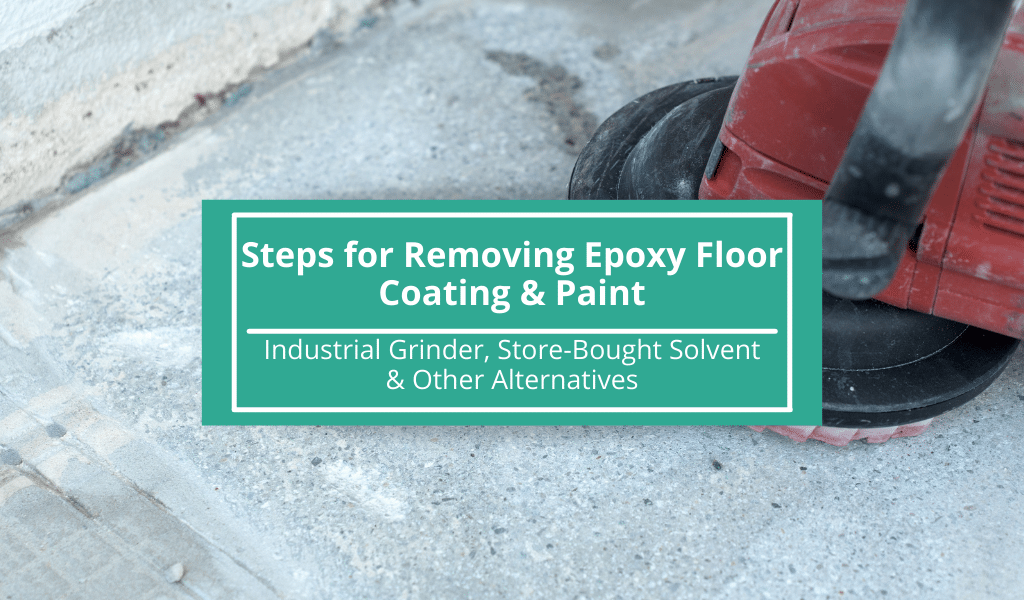Thanks to its tough, hard-wearing features, epoxy has long been a popular and reliable option for industrial-grade floors. Epoxy floors can be dressed in anti-slip coatings and can be developed to serve a range of industrial and commercial needs.
But what happens when it’s time to change your epoxy flooring? Or, perhaps you’ve recently taken out a lease on a building, and you want to remove the epoxy floor – how do you go about it?
This article explains how to remove epoxy floors safely and effectively, so you don’t damage the concrete base upon which it is laid.
What is Epoxy Flooring?
Epoxy flooring is sometimes referred to as resinous or polymer flooring, which denotes its composition. Epoxy is a two-part mixture that contains both resin and hardener, and it is most commonly placed on top of concrete in industrial, commercial, and even some residential settings.
People opt for epoxy flooring because the chemical bond between its component parts forms a hard plastic that is extremely tough and durable. It also cures quickly, meaning you don’t have to wait for too long before you can resume your operations.
How Do You Remove Epoxy Flooring?
If you’re tasked with removing epoxy flooring, you’re in for a tough job! The first thing you need to do is to recognize the difference between epoxy paint and epoxy floor coating. Here’s a helpful distinction to guide you:
- Epoxy floor coatings are the composite mixture between resin and hardener, as introduced in the previous section. It’s exceptionally durable and was likely laid to last a lifetime, which means it will be extremely difficult to remove without the help of a professional.
- Epoxy paint, on the other hand, tends to be a latex acrylic product that has some epoxy in the mixture. It will be more hard-wearing than other acrylic paints but won’t be anywhere near as resistant as epoxy floor coatings and is, therefore, easier to remove.
How to Remove Epoxy Floor Coatings
The main way to successfully remove epoxy floor coatings from concrete is to grind them away. Unless you have one yourself, you will need to hire or purchase an industrial grinder built for the job. Handling industrial grinders requires skill and is a delicate process, as you don’t want to damage the surface underneath the epoxy. As such, your best bet is to hire a floor removal specialist to assist you.
Grinding epoxy floor coating away is much safer than using a shop-bought solvent, as the latter will result in heat and fumes emanating from the epoxy. It’s safe to say that removing epoxy floor coatings is laborious and complicated, so hiring a skilled professional to help you is the best way forward.
How to Remove Epoxy Paint from Floors
If you’re confident that your flooring is covered with epoxy paint, however, there are a range of ways that you can try and remove it without necessarily calling for the help of a professional. Below are three methods that you can try to remove epoxy paint from your flooring:
Use an Epoxy Paint Stripper
While regular paint stripper is unlikely to be effective when tasked with removing epoxy paint from your floor, epoxy paint stripper might do the trick. The key ingredient within the stripper is methyl ethyl ketone (MEK), which works to break down the epoxy and makes it easier to strip. To use the epoxy paint stripper, you will need to do the following:
- Apply the paint stripper to the area using a mop or sufficiently sized paintbrush.
- Refer to the packaging and leave the stripper on the surface of your floor for the recommended time.
- Leave the room for the allotted time, and open any windows to allow the fumes to escape.
- When you return to the floor, use a paint scraper or putty knife to remove the epoxy paint.
- You may need to repeat this process several times to remove the epoxy successfully.
Use an Acetone-based Solution
If you’ve had no luck with (or choose not to purchase) an epoxy paint stripper, an acetone solution is a decent alternative. Acetone can be found in a range of household products, but if you’re tasked with removing a large area of epoxy paint from your floor, you will need to invest in a shop-bought acetone solution that provides an appropriate concentration of acetone for your needs.
Try a Heat Gun
If you have a heat gun, you might be able to soften the epoxy paint sufficiently, which allows you to remove it with a putty knife or scraper after application. However, for a heat gun to be effective on epoxy, you will need to heat the surface to 200 degrees. As such, you will need to use a heat gun that enables temperature control. A heat gun won’t be sufficient if you need to remove a large area of epoxy paint from your floor.
Removing Epoxy Flooring: A Summary
By its very design, epoxy flooring is extremely stubborn and won’t be easy to remove. However, its hard-wearing, tough features that made it so suitable to be laid in the first place will make your life difficult when trying to remove it.
But it’s not impossible.
If you’re trying to remove an epoxy floor coating, which is most likely to be present in an industrial or commercial property, we would advise you to consult the services of a skilled professional, as they will need to use a suitable industrial grinder to remove the epoxy successfully. Because this process is delicate, you’re better not to try it yourself as you risk damaging the floor underneath the epoxy.
However, if you’re trying to remove epoxy paint from your floor, you might have success with one of the three ‘DIY’ methods listed above. But if you experience difficulties or aren’t confident with any of the solutions introduced, you should opt to hire a professional to take care of the job for you.

